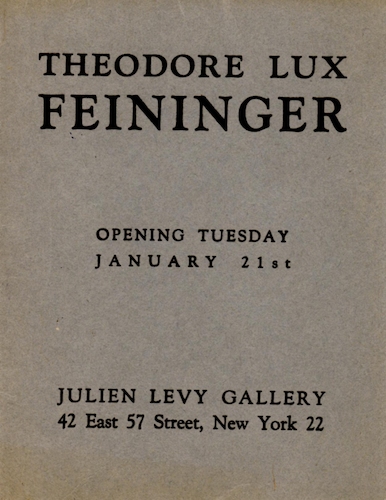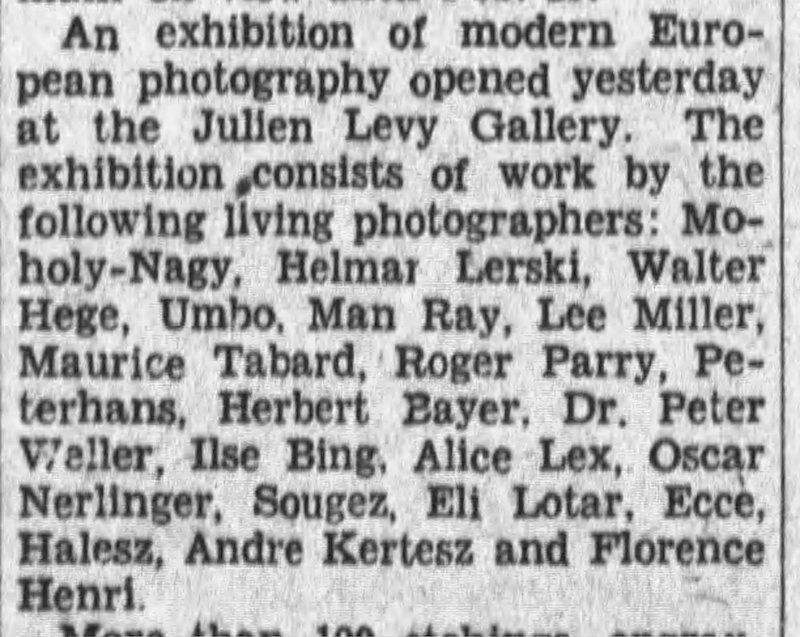Archive
Julien Levy Gallery
- Julien Levy Gallery
- Art Gallery
The Julien Levy Gallery was founded by the art dealer Julien Levy (1906–1981) in 1931, and was situated in the New York gallery district around 57th Street, where the Weyhe and Norlyst Gallery were also located.
Word Count: 34
607 Madison Avenue, Central Park South, Manhattan, New York City (1931–1937); 15 East 57th Street, Central Park South, Manhattan, New York City (1937–1941); 15 East 57th Street, Central Park South, Manhattan, New York City (1942–1943); 42 East 57th Street, Central Park South, Manhattan,New York City (1943–1949).

T. Lux Feininger, The Painter Muriel Streeter and Julien Levy, 1940, New York (© The Estate of T. Lux Feininger, Repro: www.Kunst-Archive.net). 
Exhibition flyer Paintings of Ships by T. Lux Feininger at the Julien Levy Gallery from May, 7 until December, 31 1937 (© T. Lux Feininger Estate). 
Exhibition flyer by Theodore Lux Feininger at the Julien Levy Gallery from January, 21 until January, 31 1947 (© T. Lux Feininger Estate). 
Announcement of the exhibition Modern European Photography at the Julien Levy Gallery (The Brooklyn Daily Eagle, 21 February 1932, p. 52). New York Photography 1890–1950. Von Stieglitz bis Man Ray, edited by Ortrud Westheider and Michael Philipp, exh. cat Bucerius Kunst Forum, Hamburg, 2012.
Rosenblum, Naomi. A History of Women Photographers. Abbeville Press, 1994.
Schaber, Irme. “Fotografie.” Handbuch der deutschsprachigen Emigration 1933–1945, edited by Claus-Dieter Krohn and Patrick von zur Mühlen, WBG, 1998, pp. 970–983.
Schaffner, Ingrid, and Lisa Jacobs, editors. Julien Levy. Portrait of an Art Gallery. MIT Press, 1998.
Travis, David. Photographs from the Julien Levy Collection. Starting von Atget, exh. cat. The Art Institute of Chicago, Chicago, 1976.
Ware, Katherine, and Peter Barberie. Dreaming in black and white: photography at the Julien Levy Gallery, exh. cat. Philadelphia Museum of Art, Philadelphia, 2006.
Word Count: 106
- 02-11-1931
- 04-1949
T. Lux Feininger, Ilse Bing.
- New York
- Helene Roth. "Julien Levy Gallery." METROMOD Archive, 2021, https://archive.metromod.net/viewer.p/69/2948/object/5145-11007220, last modified: 06-05-2021.
-
Rolf TietgensPhotographerEditorWriterNew York
Rolf Tietgens was a German émigré photographer who arrived in New York in 1938. Although, in the course of his photographic career, his artistic and surrealist images were published and shown at exhibitions, his work, today, is very little known.
Word Count: 39
Lotte JacobiPhotographerNew YorkIn October 1935 the German émigré photographer Lotte Jacobi, together with her sister Ruth Jacobi, opened a photo studio on 57th Street. The two sisters had to leave their parents' photo studio in Berlin in the 1930s and emigrated to New York.
Word Count: 41
Ruth JacobiPhotographerNew YorkRuth Jacobi was a German-speaking, Polish-born photographer who emigrated in 1935 to New York, where she opened a studio together with her sister Lotte Jacobi. She later had her own portrait studio.
Word Count: 31
T. Lux FeiningerPhotographerPainterNew YorkLux T. Feininger was a German-American émigré photographer and painter and the brother of the photographer Andreas Feininger, arriving in 1936 in New York. Although he started taking photographs during the 1920s in Germany, Feininger is better known for his career as a painter and his photographic work is largely unacknowledged.
Word Count: 50
Camera FeaturesPhoto AgencyNew YorkCamera Features was a photo agency founded by the photographer Werner Wolff and other colleagues of the photo agency PIX.
Word Count: 20
Norlyst GalleryGalleryArt GalleryNew YorkFounded in 1943 by the American painter and art collector Elenore Lust, the Norlyst Gallery represented a cross section of contemporary painting, photography and other media focusing on surrealist and abstract expressionist styles and promoting women artists and photographers.
Word Count: 38
Weyhe GalleryArt GalleryNew YorkOpened in 1919 by the German-born art dealer Erhard Weyhe opened a bookstore and gallery space specialised in contemporary European artists and was the first to specialise in prints.
Word Count: 28
American-British Art CenterArt CenterNew YorkThe émigré gallerist Ala Story left London for New York around 1940, where she co-founded the American-British Art Center, which introduced British and US artists to the public.
Word Count: 27
László Moholy-NagyPhotographerGraphic DesignerPainterSculptorLondonLászló Moholy-Nagy emigrated to London in 1935, where he worked in close contact with the local avantgarde and was commissioned for window display decoration, photo books, advertising and film work.
Word Count: 30
Andreas FeiningerPhotographerWriterEditorNew YorkAndreas Feininger, was a German émigré photographer who arrived in New York with his wife Wysse Feininger in 1939. He started a lifelong career exploring the city's streets, working as a photojournalist and writing a large number of photography manuals.
Word Count: 39